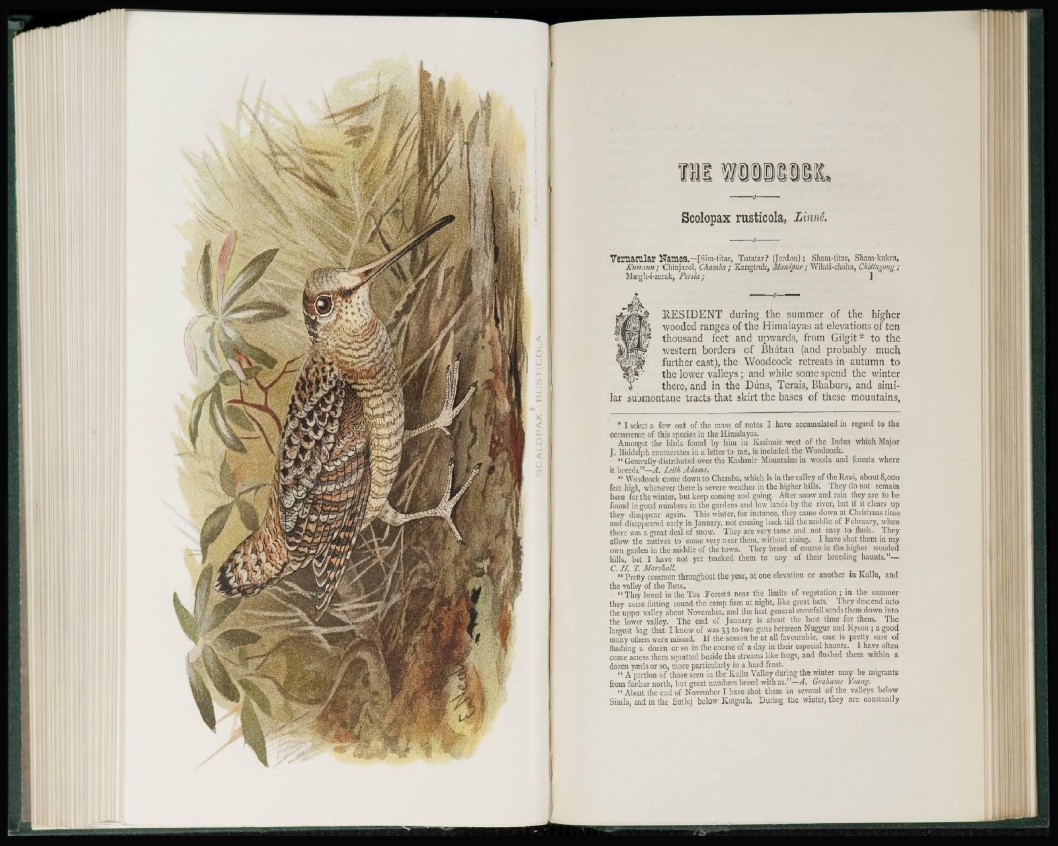
Scolopax rusticóla, Linne.
Vernacular ITaiaSS.— [Sim-titar, Tutatar? (Jerdon)j Shani-titar, Sham-kukra, KumatiK; Chinjarol, Chamba; Kangtruk, Manipur; Wilati-chaha, Ckütagong;
Murgli-í-zerak, Persia; ]
RESIDENT during the summer of the higher
wooded ranges of the Himalayas at elevations of ten
thousand feet and upwards, from Gilgit* to the
western borders of Bhutan (and probably much
further east), the Woodcock retreats in autumn to
the lower valleys ; and while some spend the winter
there, and in the Duns, Terais, Bhaburs, and similar
submontane tracts that skirt the bases of these mountains,
* I select a Tew out of the mass of notes I have accumulated in regard tu the
occurrence of this species in the Himalayas.
Amongst the birds found by him in Kashmir west of the Indus which Major
J. Biddulph enumerates in a letter to me, is included the Woodcock.
" Generally distributed over the Kashmir Mountains in woods and forests where
it bieeds."—A. Leith Adams.
" Woodcock come down to Chamba, which is in the valley of the Ravi, about S,ooo
feet high, whenever there is severe weather in the higher hills. They do not remain
here fur the winter, but keep coming and going. After snow and rain they are to be
found in good numbers in the gardens and low lands by the river, but if it clears up
they disappear again. This winter, for instance, they came down at Christmas time
and disappeared early in January, not coming back till the middle of February, when
there was a great deal of snow. They are very tame and not easy to flush. They
allow the natives to come very near them, without rising. I have shot them in my
own garden in the middle of the town. They breed of course in the higher wooded
hills, but I have not yet tracked them to any of their breeding haunts."—
C. If. 7\ Marshall.
" Pretty common throughout the year, at one elevation or another in Kullu, and
the valley of the Beas.
"They breed in the Tos Forests near the limits of vegetation ; in the summer
they come Hitting round the camp fires at night, like great bats. They descend into
the upper valley about November, and the fiat general snowfall sends them down into
the lower valley. The end of January is about the best time for them. The
largest bag that I know of was 33 to two guns between Nuggur and Hyson ; a good
many others were missed. If the season be at all favourable, one is pretty sure of
flushing a dozen or so in the course of a day in their especial haunts. I have often
come across them squatted beside the streams like frogs, and flushed them within a
dozen yards or so, more particularly in a hard frost.
" A portion of those seen in the Kullu Valley during the winter may be migrants
from further north, but great numbers breed with us."—A. Grahame Young.
" About the end of November I have shot them in several of the valleys below
Simla, and in the Sutkj below Kotgaih, Daring the winter, they arc constantly